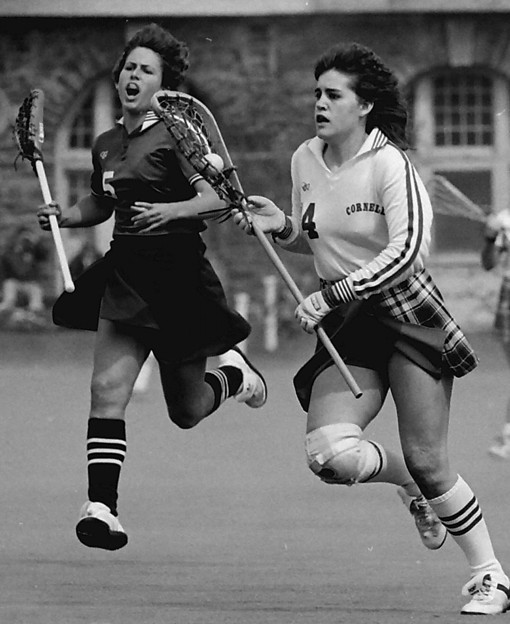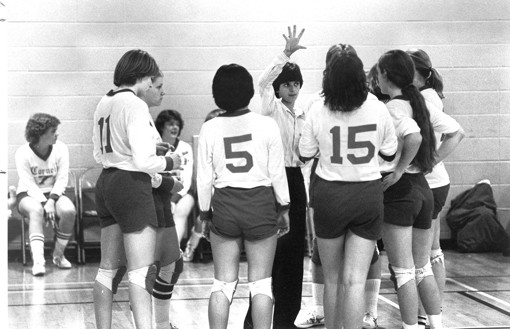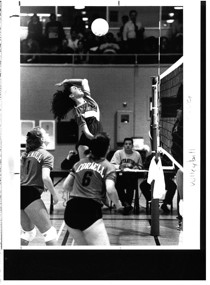LET'S GO BIG RED
40 years forward -- Title IX at Cornell

Jenny Graap '86 on the field, playing for the women's lacrosse team in 1983.
"No person in the United States shall, on the basis of sex, be excluded from participation in, be denied the benefits of, or be subjected to discrimination under any education program or activity receiving federal financial assistance."
Those words are from Title IX, a section of the education amendments signed into law 40 years ago by President Richard Nixon on June 23, 1972.
While the amendments dealt with widespread inequities in educational opportunities, Title IX rocked the foundation of athletic departments nationwide and led to scores of women participating in athletics at far greater rates than ever before.
Women's athletics at Cornell was still in its infancy in 1972 – just a handful of sports were available for women; but today, more than 450 female student-athletes participate in 18 varsity sports.
Andrea Dutcher, the Robert E. Browning '56 Director of Physical Education, has seen this transformation firsthand. A standout golfer and basketball player at Penn State, she came to Cornell in 1974 to teach physical education. Dutcher had been on the job just two days when she was given the head coaching positions for volleyball and skiing as a way to supplement her income. She is the all-time winningest volleyball coach in Big Red history, and the Ivy League's championship trophy is named in her honor.

Andrea Dutcher See larger image
"I knew nothing about volleyball," says Dutcher. "But that's the way women's athletics was at the time. All the women held several positions, and sometimes they weren't really qualified" for some of them. Overlapping coaching duties is something Big Red head women's lacrosse coach Jenny Graap '86 remembers well from her undergraduate days at Cornell. A two-sport athlete competing in field hockey and lacrosse, Graap points out that her field hockey coach, Shelby (Pontz) Bowman, served as the women's lacrosse assistant coach despite having never played the sport.
"Assistants also headed up the junior varsity squads," adds Graap. "So you had a coach with very little experience in that sport running a program, and that really limited the ability to develop a student-athlete because the expertise wasn't there.
"When you look at the women's programs now, coaches are well paid, so you can actually make a living being a coach, even as an assistant. So now you have multiple trained, experienced coaches on the field, which expands everyone's knowledge and allows you to really develop talent in a way that wasn't possible in the early days of Title IX." The size and quality of coaching staffs are not the only things that have changed over the years. Women's sports now enjoy the full range of support from the athletic department.
At most women's sporting events today, the facilities have been set up by department workers, the student-athletes have been taped by an athletic trainer devoted solely to their team, game programs have been provided by the Department of Athletic Communications, and refreshment stands are run by Premiere Catering.

Andrea Dutcher (center) coaches the women's volleyball team in 1979.

In 1989, Lisa Olshein and her Big Red teammates won their second consecutive New York state crown while sporting a perfect 7-0 record against Ivy League opponents. See larger image
In Dutcher's days, the scene was much different.
"As the coach, I set up the gym and tore it down afterward," she recalls. "I cleaned the floors, I taped the kids, I wrote the stories for the newspaper, we made our own programs, and we ran the refreshment stand to make money for the program. … The men's and women's athletic departments were separate at the time and what I was doing was what all women's coaches were doing, so we thought it was normal. And honestly, we had a blast and we were just happy to have the opportunity to play!"
As time went on, just having the opportunity to play wasn't enough, and more and more female athletes and coaches began to demand a more level playing field. In the late 1970s, the men's and women's athletic departments at Cornell merged, and with lawsuits being filed around the country to enforce Title IX, Dutcher began to see positive changes.
"The excitement and involvement of the female student-athletes were really the driving force for change," she says. "The beauty of sports is that you learn self-confidence and assertiveness. And that is what those women then used to demand more of the department. Sports gave them a voice, and they used it."
Female student-athletes have continued to use their voices, and Cornell continues to make strides in equality. Recently, a commitment to upgrade women's facilities has come to the forefront. Inequities in the men's and women's rowing facilities led to the department's recent $8 million renovation to the Cornell University Rowing Center. Field hockey has a new home in Marsha Dodson Field, and the women's lacrosse coaches have new offices adjacent to Schoellkopf Field. The women's lacrosse and women's ice hockey teams have seen upgrades in their locker rooms, and this past winter, Andy Noel, the Meakem*Smith Director of Athletics and Physical Education, announced plans for a significant upgrade to the Niemand*Robison Softball Field.

Cornell's field hockey team now has the state-of-the-art Marsha Dodson Field that can lure some of the nation's top programs to East Hill, like this game against the University of Virginia. In 2012 the Big Red will open its home schedule against the University of North Carolina, a team that last season advanced to the national championship game. See larger image
"There have just been a million little changes for the better," says Graap. "When I was here in the mid-'80s, we didn't have our own locker room. … We [the lacrosse team] also shared uniforms with the field hockey team, and when I was hired in 1997, they were still sharing uniforms. I told Charlie Moore, the athletic director at the time, that I would not take the job unless women's lacrosse got its own uniforms. It seems like such a small thing, but I remember that experience as an athlete and I thought that it was important to give my team its own identity and to instill program pride and to give them a better experience."
She adds: "As a coach, it is important to focus on all we do have. I feel like our women's teams have what we need to compete and be successful. We went from being regionally competitive during my time as a player to being nationally competitive in my time as a coach, and that's a direct result of increased money, resources and support. We've crossed a huge threshold, and I'm proud of how far we've come as an athletic department."